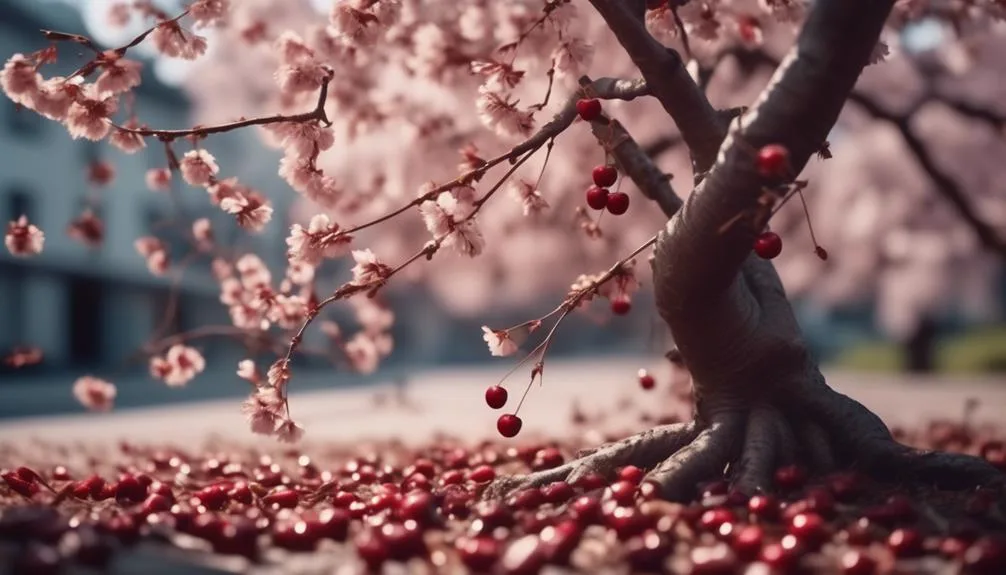Cherry trees can suffer significant damage from strong winds due to their delicate branches and blossoms. This vulnerability makes them prone to various wind-related issues.
Understanding the impact of strong winds on cherry trees, recognizing signs of damage, and learning how to prevent and recover from it is crucial for their care.
Whether you're a seasoned gardener or just love cherry blossoms, knowing how wind affects these trees is essential for their preservation.
Vulnerability of Cherry Trees to Strong Winds
Cherry trees are particularly vulnerable to strong winds due to their delicate branches and shallow root systems. When strong winds blow, these beautiful trees are at risk of damage and uprooting. To mitigate this vulnerability, it's crucial to provide proper tree support.
Consider installing tree stakes to stabilize the young cherry trees and prevent them from swaying excessively in the wind. Additionally, selecting wind-resistant species can make a significant difference. Some cherry tree varieties are naturally more adept at withstanding strong winds, with sturdier branches and deeper root systems.
When choosing cherry trees for planting, look for varieties known for their wind resistance to ensure they can better withstand strong gusts. By addressing these vulnerabilities and taking proactive measures, you can help protect your cherished cherry trees from the damaging effects of strong winds.
Impact of Strong Winds on Cherry Trees
When strong winds strike, cherry trees can suffer significant damage, leading to broken branches and potential uprooting. The impact of strong winds on cherry trees is substantial, and understanding resilience strategies and root anchoring is crucial to mitigate damage.
| Resilience Strategies | Description |
|---|---|
| Pruning | Regular pruning helps maintain the tree's shape and reduces wind resistance. |
| Mulching | Applying a layer of mulch around the base of the tree helps to insulate the soil and stabilize root temperature. |
| Windbreaks | Planting windbreaks such as shrubs or erecting fences can shield cherry trees from strong winds. |
Implementing these resilience strategies can enhance the tree's ability to withstand strong winds and minimize potential damage. Additionally, ensuring proper root anchoring through deep and strong root systems is essential for anchoring the tree securely and preventing uprooting during storms.
Signs of Wind Damage on Cherry Trees
After enduring strong winds, you may notice various signs of damage on your cherry trees. Keep an eye out for these indicators to assess the impact and take appropriate action:
- Broken or Split Branches: Look for any branches that may have snapped or split due to the force of the wind.
- Leaning or Uprooted Trees: Check if the tree has been uprooted or is leaning at an unusual angle, indicating damage to the roots.
- Torn or Damaged Leaves and Blossoms: Inspect the leaves and blossoms for tears, bruises, or other signs of damage caused by the wind.
To prevent damage and promote recovery, consider implementing proper pruning techniques to remove any broken or damaged branches. Pruning can help the tree regain its shape and strength, reducing the risk of further damage during future windy conditions.
Preventing Wind Damage to Cherry Trees
To safeguard your cherry trees from wind damage, it's essential to employ strategic planting and supportive structures to fortify their resilience.
Start by choosing wind-resistant cherry tree varieties such as the Yoshino cherry or the Kwanzan cherry, known for their ability to withstand strong winds. These varieties are less likely to suffer from wind damage compared to others.
Additionally, consider providing structural support for your cherry trees. Install wooden stakes or metal poles and use soft ties to secure the tree trunk, providing stability during windy conditions.
Alternatively, you can use windbreaks such as fences or hedges to create a barrier that reduces the impact of strong winds on your cherry trees.
Recovering Cherry Trees From Wind Damage
If your cherry trees have suffered wind damage, the road to recovery involves prompt and careful intervention to restore their health and vigor.
First, assess the extent of the damage by inspecting the branches, trunk, and roots for any signs of injury.
Next, consider implementing rehabilitation techniques such as pruning to remove any broken or damaged branches, promoting new growth.
Additionally, tree staking can provide vital support to help the tree regain its stability and prevent further damage. Ensure the stakes are placed a few feet away from the trunk and aren't tied too tightly to allow for natural movement.
Conclusion
Cherry trees are vulnerable to wind damage, which can hinder their growth and overall well-being. Look out for signs like broken branches, leaning trunks, and wilting leaves.
To mitigate this risk, opt for wind-resistant varieties and provide support for young trees. If wind damage occurs, take proactive measures such as pruning and additional support to aid the trees' recovery.
Consider the long-term resilience of your cherry trees when planning and caring for them.

My interest in trees started when I first saw the giant sequoias in Yosemite.
I was a teenager then, and I remember thinking, “I need to learn more about this.”
That moment stuck with me.
A few years later, I went on to study forestry at Michigan Tech.
Since graduating, I’ve worked in a mix of hands-on tree care and community education.
I’ve spent over ten years helping people understand how to plant, maintain, and protect the trees in their neighborhoods.
I don’t see trees as just part of the landscape.
They are living things that make a real difference in our daily lives.
